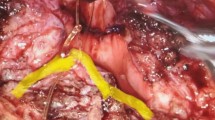Abstract
Objectives
The aim of the study was to investigate whether a novel simple measurement of pelvic anatomy, the pelvic anatomical index (PAI), which is obtained from simple physical examination, was predictive for potential difficulty and adverse outcome in radical prostatectomy.
Materials and methods
Available data from 73 consecutive radical prostatectomy patients were analyzed. The distances between umbilicus and cranial edge of the symphysis pubis (USPD) and between root of the penis and umbilicus (PUD) were measured. PAI was obtained using the formula (PUD/USPD) × body mass index (BMI). Indicators of surgical difficulty assessed were operation time (OT), dorsal vein bleeding (DVB), total blood loss (TBL), and surgical margin (SM) status. Patients with below-median values of the OT, DVB, TBL, and had negative SM were grouped as favorable surgery (n = 18).
Results
Median OT, DVB, and TBL were 215 (IQR: 187.5–240) min, 380 (IQR: 200–500) cc, and 1000 (IQR: 700–1300) cc, respectively. Both PAI and BMI were significantly correlated with TBL, DVB, and OT (p < 0.05, for all). PAI and BMI significantly associated with favorable surgery (p = 0,006 and p = 0.048, respectively). However, only PAI was an independent predictor of favorable surgery in multivariable logistic regression analysis. A PAI 36 kg/m2 was determined as the threshold value for favorable surgery with 83.3% sensitivity and 60% specificity.
Conclusion
PAI significantly correlated with almost all surgical parameters and was a significant independent predictor of favorable surgery. PAI can enable the physician to select and discuss individualized treatment options for patients during preoperative planning.



Similar content being viewed by others
Data availability
The data supporting the findings of this study are available from the corresponding author upon reasonable request.
References
Hong SK, Chang IH, Han BK, Yu JH, Han JH, Jeong SJ et al (2007) Impact of variations in bony pelvic dimensions on performing radical retropubic prostatectomy. Urology 69:907–911
Chen J, Chu T, Ghodoussipour S, Bowman S, Patel H, King K et al (2019) Effect of surgeon experience and bony pelvic dimensions on surgical performance and patient outcomes in robot-assisted radical prostatectomy. BJU Int 124(5):828–835. https://doi.org/10.1111/bju.14857
Matikainen MP, Von Bodman CJ, Secin FP, Yunis LH, Vora K, Guillonneau B et al (2010) The depth of the prostatic apex is an independent predictor of positive apical margins at radical prostatectomy. BJU Int 106:622–626
Neill MG, Lockwood GA, McCluskey SA, Fleshner NE (2007) Preoperative evaluation of the ‘hostile pelvis’ in radical prostatectomy with computed tomographic pelvimetry. BJU Int 99:534–538
Ongun S, Demir O, Gezer NS, Gurboga O, Bozkurt O, Secil M (2015) Impact of pelvic biometric measurements, visceral and subcutaneous adipose tissue areas on trifecta outcome and surgical margin status after open radical retropubic prostatectomy. Scand J Urol 49:108–114
Özkaptan O, Karadeniz T, Guzelburc V, Yilmaz K, Yilanoğlu O, Sahin S (2013) The effects of pelvic dimensions on radical retropubic prostatectomy. Can J Urol 20:6761–6767
von Bodman C, Matikainen MP, Yunis LH, Laudone V, Scardino PT, Akin O et al (2010) Ethnic variation in pelvimetric measures and its impact on positive surgical margins at radical prostatectomy. Urology 76:1092–1096
Scardino P, Slawin K. Atlas of the Prostate. Third ed. Ankara: Güneş Tıp Kitabevleri; 2009.
Boyle K, Petty D, Chalmers A, Quirke P, Cairns A, Finan P et al (2005) MRI assessment of the bony pelvis may help predict resectability of rectal cancer. Colorectal Dis 7:232–240
Michel SC, Rake A, Treiber K, Seifert B, Chaoui R, Huch R et al (2002) MR obstetric pelvimetry: effect of birthing position on pelvic bony dimensions. Am J Roentgenol 179:1063–1067
Funding
The authors did not receive support from any organization for the submitted work.
Author information
Authors and Affiliations
Contributions
All authors contributed to the study conception and design. Material preparation, data collection and analysis were performed by MEK, AKU, and IEA. The first draft of the manuscript was written by HY and MEK. The critical review and editing of the original draft were performed by OD and KT. All authors commented on previous versions of the manuscript. All authors read and approved the final manuscript.
Corresponding author
Ethics declarations
Conflict of interest
The authors have no relevant financial or non-financial interests to disclose.
Ethics approval
Approval was obtained from the ethics committee of Kocaeli University. The procedures used in this study adhere to the tenets of the Declaration of Helsinki. (KU GOKAEK 2019/138).
Additional information
Publisher's Note
Springer Nature remains neutral with regard to jurisdictional claims in published maps and institutional affiliations.
Rights and permissions
About this article
Cite this article
Kosem, M.E., Yilmaz, H., Uslubas, A.K. et al. The pelvic anatomic index is an independent predictor for the difficulty of radical prostatectomy. Int Urol Nephrol 54, 1529–1535 (2022). https://doi.org/10.1007/s11255-022-03206-4
Received:
Accepted:
Published:
Issue Date:
DOI: https://doi.org/10.1007/s11255-022-03206-4




